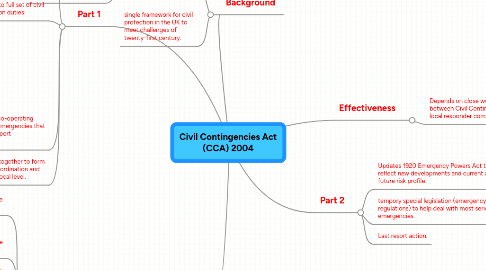
1. Background
1.1. made up of two parts.
1.1.1. Local arrangements for civil protection-Part 1.
1.1.2. Emergency Powers-Part 2
1.2. single framework for civil protection in the UK to meet challenges of twenty-first century.
2. Part 1
2.1. clear set of roles and responsibilities for those involved in emergency preperation and response at local level.
2.2. Category 1 organisations at core of response to emergencies e.g. Ambulance Service, subject to full set of civil protection duties:
2.2.1. 1) Assess the risk of emergencies occuring and use this to inform contingency planning.
2.2.2. 2) Put in place emergency plans.
2.2.3. 3) Put in place business continuity management arrangements.
2.2.4. 4) Put in place arrangements to make information available to the public about civil protection matters and maintain arrangments to warn, inform, and advise the public in the event of an emergency.
2.2.5. 5) Share information with other local responders to enhance co-ordination.
2.2.6. 6) Co-operate with other local responders to enhance co-ordination and efficiency.
2.2.7. 6) Provide advance and assistance to businesses and voluntary organisations about business continuity managment.
2.3. Category 2 organisations, ''co-operating bodies'' heavily involved in emergencies that affect their sector e.g. transport companies.
2.3.1. Lesser set of duties: co-operating and sharing relevent inforation with other category 1 and 2 responders.
2.4. Category 1 and 2 organisations will come together to form local resilience forums, which will help co-ordination and co-operation between responders at the local level.
3. Enhancement programme
3.1. Objectives:
3.1.1. 1) check original intentions of CCA are being met and develop solutions where needed.
3.1.2. 2) Consider whether CCA can be modified to reflect relevent experience and changes in relevent structures which have emerged since 2004.
3.1.3. 3) Consider how to reflect good practice in the CCA regime and help raise standards of Uk resilience activity.
3.1.4. 4) Evaluate whether scope of CCA should be broadened beyond emergency preparedness to cover other aspects of intergrated emergency management.
3.1.5. 5) Ensure that CCA framework is effectively aligned and intergrated with relevent legislation and policy initiatives.
3.2. objectives met vis range of projects, organised into 4 phase programme.
4. Part 2
4.1. Updates 1920 Emergency Powers Act to reflect new developments and current and future risk profile.
4.2. tempory special legislation (emergency regulations) to help deal with most serious emergencies.
4.3. Last resort action.
5. Effectiveness
5.1. Depends on close working relationship between Civil Contingencies Secretariat and local responder community
5.1.1. Consultative approach will be used, ensuring there is a scope for requisite stakeholder input, key messages are delivered in a timely manner and stakeholders are fully aware of upcoming changes in CCA regime.
